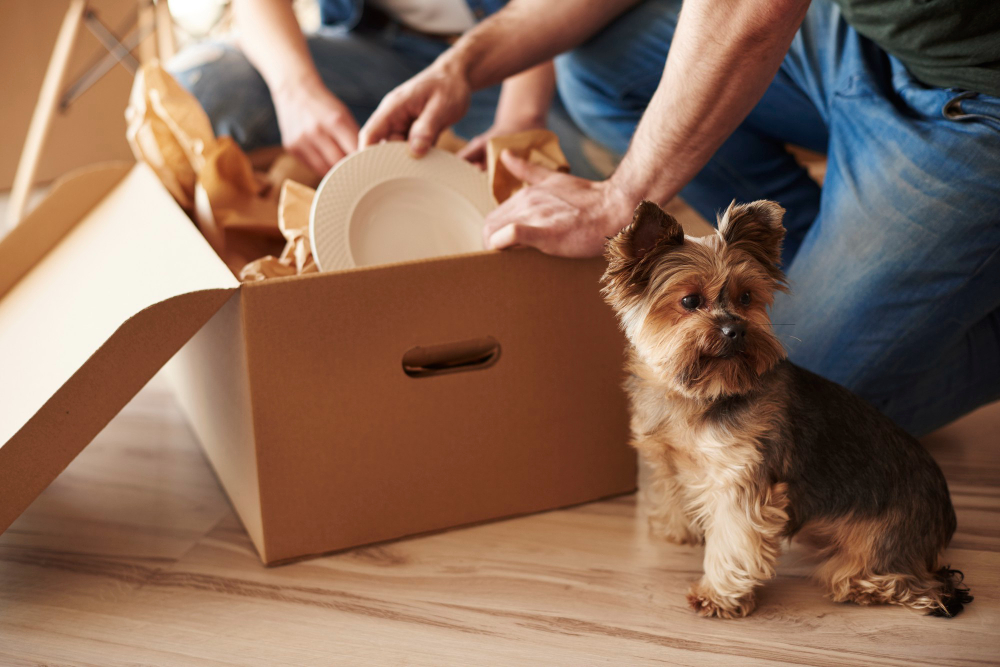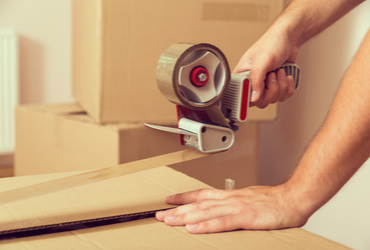Everything you need to know about moving home with pets
Paw-sitive Moves: Your Comprehensive Guide to Pet-Friendly Relocations
Welcome to Tas Removals and Storage's extensive guide for navigating the often complex process of moving home with your beloved pets. We understand that your pets are integral members of your family, and just like any other family member, they too require special attention and care when undertaking a long-distance move. Moving can be stressful for people, and it can be equally, if not more, stressful for our pets. They don't understand why their environment is changing. That's why we've created this guide, to help make the process smoother and more manageable for you and your four-legged family members.
In this guide, you'll find essential information to help you prepare effectively for the move. From understanding your pet's needs during relocation, to choosing the right carrier and prepping them for the journey, we've covered it all. We delve into expert advice on ensuring safe and stress-free travel, whether you're moving by car or plane. Health checks, vaccinations, and veterinary advice for moving are also touched upon to ensure your pet's well-being. We’ll further take you through a detailed moving checklist for pet owners and ways to help your pet adjust to their new home. Finally, discover how our dedicated team at Tas Removals and Storage can assist you in ensuring a comfortable transition for your pets during your move.
Understanding Your Pet's Needs During Relocation
Embarking on a relocation journey is like hopping onto a roller coaster ride – filled with ups, downs, and the unexpected. Now, imagine your pets are your co-passengers on this ride. They may not understand the twists and turns ahead, but they definitely sense the change in rhythm. Just as humans, each pet is a unique individual, embracing change in their own distinct way. Fido, your fun-loving Labrador, might respond to the whirlwind of packing with restlessness, a loss of appetite, or an unexpected burst of energy. Meanwhile, Whiskers, the independent feline queen, might prefer to retreat to her quiet corner, far from the moving chaos.
Picture this – it's a typical morning in your home, and Max, your loyal Golden Retriever, is eagerly awaiting his daily walk. But instead of his leash, you pick up a packing box. Or consider Bella, your demure Siamese cat, who finds her favorite sun-soaked window ledge suddenly obscured by stacked boxes. To ensure a comfortable transition, try to maintain their regular routines amidst the moving chaos. Strategically schedule packing sessions during their nap times or long walks to minimize disruption.
Pets, with their keen senses, are experts at picking up on our emotions. If you’re feeling the stress of the move, chances are, your pet will be riding that emotional wave right alongside you. Take moments to breathe, cuddle up with your furry friend, and reassure them with the language they know best - your affection. Break out their favorite toys for an impromptu play session or offer them a tasty treat as a calming distraction. A familiar blanket or toy can work wonders on moving day, offering them a safe space amidst unfamiliarity. Above all, your understanding, patience, and a sprinkle of creativity will turn this move into a pet-friendly adventure.
Choosing the Right Pet Carrier for Long-Distance Travel
Choosing an appropriate pet carrier is an integral part of your relocation planning process. It's crucial to strike a perfect balance – a carrier that’s spacious enough for your pet to move comfortably, yet snug enough to provide a secure environment during transit.
Consider, for example, your Pomeranian, Rufus. He's used to stretching and rolling freely. Placing him in a carrier that restricts these movements can cause him undue stress, leading to a challenging journey. Conversely, providing an oversized carrier to a small pet like your Persian kitten, Daisy, can create a sense of insecurity, and risks her safety during transit due to excessive movement within the carrier.
The ideal pet carrier should be large enough for your pet to stand, turn around, and lie down comfortably. However, comfort alone shouldn't dictate your choice. Safety factors, such as proper ventilation and secure closures, are critical. Ensure the carrier is sturdy and able to endure the demands of a long-distance move. A comforting touch like a familiar blanket or a piece of your clothing can help turn this seemingly alien space into a safe, comforting refuge for your pet during the journey.
Preparing Your Pet for the Big Move: Essential Steps
- Start with a Vet Check-up: Your pet's health should be your priority. Schedule a visit to the vet to ensure your pet is fit for travel. This is also the perfect time to update any vaccinations and obtain necessary health certificates if you're moving interstate or internationally.
- Acclimate Your Pet to the Carrier: If your pet isn't used to a carrier, it's essential to introduce it gradually. Start by letting them explore it freely, then encourage them to spend more time with treats and positive reinforcement.
- Maintain Routines: Changes can unsettle pets, which is why maintaining their routines - feeding times, walks, playtimes - can provide a sense of normalcy and security.
- Prepare an Overnight Kit: Pack essential supplies - food, kitty litter, toys, grooming tools - to keep your pet comfortable during the first few days of moving.
- Ensure Identification: Update your pet's ID tag or microchip information to include your new address and contact number. If your pet gets lost during the move, this will increase the chances of a safe return.
- Gradually Pack Over Time: Sudden changes can stress pets. Gradually pack over weeks to let your pet adjust to the changing environment.
- Keep Pets Away on Moving Day: The hustle of moving day might distress your pet. Consider arranging for a pet sitter, or designate a quiet room in your house where your pet can stay secure and stress-free.
- Patience and Reassurance: Lastly, remember that your pet may be confused or scared. Patience, reassurance, and plenty of affection will help them understand that the changes are not threatening.
Remember, moving can be a big deal for pets, but with the right preparation, you can help make the process less stressful for them. Your care, patience, and understanding will go a long way in ensuring a smooth transition for your pet.
Safe and Stress-Free Travel: Tips for Moving Pets by Car or Plane
Traveling by Car
-
Car Familiarization: Prior to the move, familiarize your pet with car travel by taking them on short rides. Gradually increase the length of these trips to prepare them for the long haul.
-
Secure the Carrier: The pet carrier should be securely fastened in the vehicle to prevent movement and ensure safety during the trip.
-
Take Regular Breaks: Stop every 2-3 hours to let your pet stretch, hydrate, and relieve themselves. This can significantly help in reducing their stress and discomfort.
-
Never Leave Pets Alone in the Car: Extreme temperatures inside a parked car can be dangerous for pets. Always ensure your pet is supervised.
Traveling by Plane
-
Check Airline Regulations: Each airline has specific pet travel regulations. Make sure to understand these rules and prepare accordingly.
-
Choose Direct Flights: If possible, book a direct flight to lessen the stress on your pet. Multiple layovers and plane changes can be overwhelming.
-
Visit the Vet: A pre-flight health check-up is crucial to ensure your pet is healthy and fit to fly. Ask your vet for tips to minimize your pet's anxiety during the flight.
-
Label the Carrier: Clearly label your pet's carrier with your contact information, a 'Live Animal' sign, and any special handling instructions.
Whether you choose to move by car or plane, your goal should be the same – to ensure your pet's travel experience is as comfortable, safe, and stress-free as possible. With careful preparation, and a lot of love and patience, you can help your pet navigate the journey to your new home with ease.
Health Checks and Vaccinations: Veterinary Advice for Moving
Moving homes, especially long-distance, is not only a significant change for you but also for your pets. To ensure their well-being during this period, it's crucial to take into account their health needs. Here's some veterinary advice on health checks and vaccinations for moving:
-
Routine Health Check-up: A comprehensive health check-up before the move will help determine if your pet is in good shape to handle the stress of moving. It can also identify any potential health issues that might need to be addressed beforehand.
-
Vaccination Updates: It's a good idea to ensure that your pet's vaccinations are up-to-date, especially if you're moving to a new area with different potential exposure to diseases. The essential vaccines vary depending on the type of pet, their age, lifestyle, and health status.
-
Parasite Control: Ask your vet about parasite control, especially if you're moving to a location with high prevalence of ticks, fleas, or heartworms. Your pet might need preventative treatment.
-
Health Certificates: If you're traveling interstate or internationally, you may need a health certificate from your vet, often within a certain timeframe before travel. The certificate verifies that your pet is healthy and their vaccinations are current.
-
Medications: If your pet is on any medications, ensure you have an adequate supply to last until you find a new vet at your new location. Your current vet may also provide recommendations for vets in your new area.
-
Behavioral Advice: If your pet is anxious or prone to stress, your vet may suggest behavioral techniques or medications to help your pet cope with the transition.
Remember, your vet is your best partner when it comes to safeguarding your pet's health during a move. They can provide tailored advice and a comprehensive health plan to ensure your pet's transition to their new home is as smooth and stress-free as possible.
Settling into Your New Home: How to Help Your Pet Adjust
Just as you may need time to adjust to your new surroundings, your pet, too, will need your support to settle into their new environment. Here are some tips to help your furry friend acclimate:
-
Set Up a Familiar Space: Start by setting up a dedicated space for your pet using their familiar bedding, toys, and feeding dishes. This can provide a sense of comfort and security amidst the unfamiliar.
-
Maintain Regular Routines: Consistency is key. Try to maintain your pet's usual feeding, walking, and playtime routines to help them adjust to the new environment.
-
Explore Together: Take your pet around their new home and yard. If you have a dog, regular walks around the neighborhood will help them familiarize themselves with the new smells and sights.
-
Be Patient and Supportive: Change can be stressful for pets. Offer plenty of affection and reassurance to help them understand that their new environment is safe.
-
Monitor Their Behavior: Keep an eye out for signs of stress or anxiety, such as changes in eating habits, excessive grooming, or unusual behavior. If these signs persist, consider seeking advice from a vet or a pet behaviorist.
-
Gradual Introduction to New People and Pets: If your new location involves new human or pet housemates, ensure introductions are done slowly and calmly to avoid overwhelming your pet.
Just remember, moving can be a big deal for your pet. With time, patience, and a lot of love, they'll start to understand that this new place is their home too. Before long, they'll be back to their playful, happy selves, enjoying their new abode just as much as you are.
Long-Distance Moving Checklist for Pet Owners
-
Health Check-up and Vaccinations: Schedule a comprehensive health check-up for your pet and ensure all vaccinations are up-to-date.
-
Review Pet Regulations: If you're moving interstate or internationally, check the pet regulations, quarantine requirements, and any necessary health certificates.
-
Choose a Suitable Carrier: Select a carrier that’s comfortable and secure for your pet. Ensure it meets airline specifications if you're flying.
-
Acclimate Your Pet to the Carrier: Help your pet get used to the carrier before the move by encouraging them to spend time in it.
-
Update Identification Tags: Make sure your pet's ID tags or microchip information is updated with your new address and contact details.
-
Pack a Pet Essentials Bag: Prepare a bag with necessary supplies - food, water, toys, bedding, leash, waste bags, medication, and any other pet essentials for the journey and immediate period after the move.
-
Maintain Regular Routines: Try to keep your pet's feeding, sleeping, and exercise routines as consistent as possible.
-
Arrange for Pet Care on Moving Day: Consider having a friend, family member, or professional pet sitter care for your pet on the day of the move to minimize their stress.
-
Plan Your Route: If you're driving, plan your route and schedule breaks for your pet to stretch and relieve themselves. Look for pet-friendly accommodations if your journey requires an overnight stay.
-
Prepare for Flight: If you're flying, check the airline's pet policy, prepare a suitable carrier, and consider a direct flight to reduce stress on your pet.
-
Set Up Pet Space in New Home: Upon arrival, set up a familiar space for your pet with their belongings to help them feel secure.
-
Monitor Your Pet: Keep a close eye on your pet for any signs of stress or health issues during and after the move.
By ticking off these essentials, you can ensure a smoother, more comfortable transition for your pet, turning a potentially stressful long-distance move into an exciting new adventure.
Tas Removals & Storage - Services
We want to help you move and while doing so, providing you with the best price and outcome of any move around Tasmania. We also provide backloads to Tasmania from anywhere in Australia.
Testimonials
The customer service was great. We got an affordable quote and the whole process from pickup to
delivery was a success! My partner and I are very happy with the outcome and would like to highly
recommend Tas Removals and Storage!
Tas Removals moved us from Hobart to Launceston. We couldn’t have asked for a better moving company.
Affordable, quick and effective at everything they did. Handled everything with care and made the
whole process quick and easy!
We were dreading the whole moving process. After several quotes, we spoke to TAS Removals and Storage
and decided to go with them. They communicated well and we have a slight delay, but it all worked
out really well in the end. Highly Recommended moving company!!!
These guys were great! Competent would be an understatement. They went above and beyond by hiring
more guys to help with our large move! We moved into a new home with a very long steep drive way!
They moved everything carefully during the whole process! Nothing was broken and we were extremely
happy with the overall process.
We were excited about moving. Then when it come to packing and organising everything outlined by
tas removals we got scared the whole thought process becoming daunting! They told us they could
pack everything and get it ready for the move. So we did that and it turned out great! Highly
recommended local Tassie removal company right here!!!
My wife found these guys online and I thought we would give it a go. The staff members we dealt
with were very good at communicating. Nothing was broken and everything was picked up on time and
delivered on time. Would use these guys again!
As a single man with not a lot of things. I have moved a lot over the years and I must say that
these guys were GREAT!!! Cheap, professional and the communication was good! When I move again
I will be sure to look these guys up and I would recommend you do the same
Tas removals did a backload from Melbourne to Hobart. We had a large amount of furniture to bring
and these guys were good! They handled everything carefully as I had a lot of antique furniture.
Everything was wrapped and wrapped again and then when they loaded it all on the truck it was
wrapped again with blankets of some sort. Awesome job guys! Highly recommended.
Tas Removals and Storage are an awesome company. Friendly and professional, they really cared about our move.
I can be quite pedantic about certain things but the overall move was a great success!












